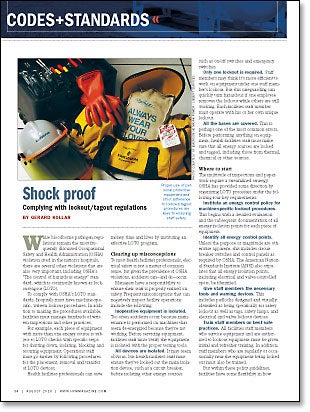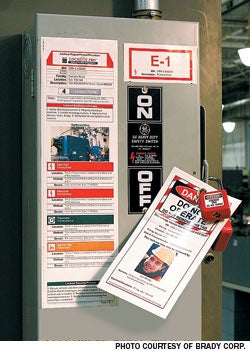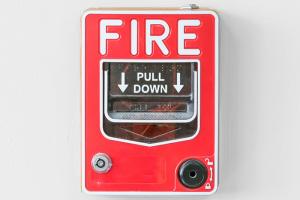Shock proof
 While bloodborne pathogen regulations remain the most frequently discussed Occupational Safety and Health Administration (OSHA) violation cited in the nation's hospitals, there are several other violations that are also very important, including OSHA's "The control of hazardous energy" standard, which is commonly known as lockout/tagout (LOTO).
While bloodborne pathogen regulations remain the most frequently discussed Occupational Safety and Health Administration (OSHA) violation cited in the nation's hospitals, there are several other violations that are also very important, including OSHA's "The control of hazardous energy" standard, which is commonly known as lockout/tagout (LOTO).
To comply with OSHA's LOTO standards, hospitals must have machine-specific, written lockout procedures. In addition to making the procedures available, facilities must manage hundreds of written inspections and other practices.
For example, each piece of equipment with more than one energy source is subject to LOTO checks with specific steps for shutting down, isolating, blocking and securing equipment. Operations staff must go further by following procedures for the placement, removal and transfer of LOTO devices.
Health facilities professionals can save money, time and lives by instituting an effective LOTO program.
Clearing up misconceptions
To most health facilities professionals, electrical safety is just a matter of common sense, but given the prevalence of OSHA violations, accidents can—and do—occur.
Managers have a responsibility to ensure their staff is properly trained on safety. Frequent misconceptions that can negatively impact facility operations include the following:
Inoperative equipment is isolated. Too often accidents occur because maintenance is performed on machines that seem de-energized because they're not working. Before servicing equipment, facilities staff must verify the equipment is isolated with the proper testing tools.
All devices are isolated. It may seem obvious, but health facilities staff must ensure they've locked out the main isolation device, such as a circuit breaker, before isolating other energy sources such as on/off switches and emergency switches.
Only one lockout is required. Staff members may think it's more efficient to work on equipment under one staff member's lockout. But this safeguarding can quickly turn hazardous if one employee removes the lockout while others are still working. Each facilities staff member must operate with his or her own unique lockout.
All the bases are covered. This is perhaps one of the most common errors. Before performing anything on equipment, health facilities staff must make sure that all energy sources are locked and tagged, including those from thermal, chemical or other sources.
Where to start
The multitude of inspections and paperwork require a streamlined strategy. OSHA has provided some direction by organizing LOTO processes under the following four key requirements:
Institute an energy control policy for machine-specific lockout procedures. This begins with a detailed evaluation and the subsequent documentation of all energy isolation points for each piece of equipment.
Identify all energy control points. Unless the purpose or magnitude are otherwise apparent, this includes circuit breaker switches and control panels as required by OSHA. The American National Standards Institute (ANSI) also stipulates that all energy isolation points, including electrical and valve-controlled spots, be identified.
Give staff members the necessary tools and warning devices. This includes padlocks designed and visually identified as being specifically for safety lockout as well as tags, safety hasps, and electrical and valve lockout devices.
 |
| User-friendly graphics can give health facilities staff the necessary lockout/tagout tools and warnings. |
Train staff members on best safe practices. All facilities staff members who service equipment and are authorized to lockout equipment must be given initial and refresher training. In addition, staff members who are regularly or occasionally near the equipment being locked out must also be trained.
But within these policy guidelines, facilities have some flexibility in how these actions are carried out. It is recommended that health facilities professionals work with suppliers that have an experienced track record working in the hospital environment. Many companies offer user-friendly solutions that can help health facilities professionals effectively meet LOTO requirements.
For example, a procedure-writing service can help hospitals and other health care facilities comply with LOTO standards by creating machine-specific procedures as required by OSHA as well as performing on-site assessments. These visually enhanced written procedures are placed directly on the equipment to ensure the facility meets or exceeds OSHA and Joint Commission requirements. Such services give staff members immediate access to lockout procedures and increase overall workplace safety throughout the facility.
Looking to the sources
Managers would be wise to revisit the LOTO standards indexed in 29 CFR 1910.147, "The control of hazardous energy (Lockout/Tagout)" (www.osha.gov/pls/oshaweb/owadisp.show_document?p_id=9804&p_table=STANDARDS).
These requirements also appear throughout the 2010 Joint Commission Environment of Care Crosswalk as related to parts of the Safety and Security standard [Elements of Performance (EP) for EC.02.01.01]; the Medical Equipment standard [EP for EC.02.04.03]; the Utilities standard [EP for EC.02.05.05]; and the Role and Responsibilities standard (with respect to training) [EP for EC.03.01.01].
The Environment of Care Crosswalk is a reference document that indicates a variety of codes, standards and regulations that could be considered applicable to various elements of performance, but The Joint Commission does not survey for OSHA compliance based on this document. Other regulations from OSHA are also applicable to the environment of care as follows:
General Environmental Controls permit-required confined spaces—29 CFR 1910.146. This OSHA section focuses on confined spaces such as tanks, reservoirs and even equipment control areas that have limited or restricted means for entry or exit. This is intended to protect employees from the hazards of such spaces that have at least one of the following characteristics:
• They contain or potentially contain a hazardous atmosphere;
• They contain a material that could engulf a worker who enters the space;
• They have an internal configuration that could trap a worker or asphyxiate him or her by inwardly converging walls; or
• They contain any other recognized serious safety or health hazard.
Walking-Working Surfaces and Means of Egress general requirements—29 CFR 1910.22 and 29 CFR 1926.34. These OSHA requirements apply to all permanent places of employment. Common problem areas such as stairways, passageways, exits and aisles, are discussed in these sections.
Facility safety labeling requirements—OSHA, The Joint Commission and the American Society of Mechanical Engineers. These organizations provide information on pipe-marking, electrical control panel labeling for arc flash and electrical safety, guarding machines and on restricted areas.
For example, quick guidance on marking colors includes the following:
• Red is used to identify fire protection equipment and apparatus, containers of flammable liquids and emergency stop bars on hazardous machines; and
• Yellow is used for designating caution areas and for marking physical hazards.
Overlooked areas
While LOTO requirements touch on a variety of spaces throughout a facility, confined spaces, safety labeling and slip-and-fall safety tend to be three commonly overlooked compliance areas.
When it comes to confined spaces, for example, hospitals have a number of potentially hazardous areas that require a permit and documented precautionary safety steps. However, the requirement to develop comprehensive procedures is complex. Compliance requires health care facilities to audit confined spaces and develop visual procedures to provide for
safe entry.
Similarly, health care facilities can never have too much safety labeling. Facilities have multiple pipes, tanks, vessels, passageways, egress routes, electrical panels and portable fire protection equipment that each require signs or labels for safety and regulatory compliance purposes. The list often can be too extensive for safety and maintenance staff to maintain.
Completing a facility audit can provide a cost-effective solution for ensuring the accuracy and comprehensiveness of a health care facility's safety signage, equipment and pipe-marking practices.
An audit's areas of focus should include the following:
Assessment of the current safety identification program. This should look at regulations and standards compliance with OSHA, ANSI and others as well as how effectively and consistently safety is communicated to employees.
Preparation of a comprehensive report. This report should include corrective actions, such as signage that brings the health care facility into compliance with the requirements of the authorities.
A complete list of required and recommended identification products. These include arc flash and other electrical safety labels, pipe-marking labels and even machine guarding labels.
Finally, health facilities professionals must not overlook safety for walking and working surfaces. Facilities professionals can limit their overall liability by completing a comprehensive "slips, trips and falls" audit of the facility, detailing the required and recommended steps to correct a facility's safety shortcomings.
Areas of assessment should include the following:
• Aisles and passageways, slippery surfaces and floor loading;
• Risers, treads, rails and handrail maintenance and use;
• Docks, ramps, floors and wall openings;
• Procedures for ladders, scaffolds and fall protection; and
• Visibility, spill containment and cleanup, and emergency egress.
Compliance is not optional
The list of procedures that goes into meeting LOTO standards sometimes can drain resources and detract health facilities professionals from their daily tasks.
However, suppliers can help guide managers through the maze with resources to avoid negative outcomes.
Compliance can help health care facilities reduce insurance premiums, legal liabilities and financial exposure, all while boosting morale by providing hospital employees with a safe and secure working environment. hfm
Gerard Kollar is director of the commercial market for Graybar Electric Company Inc. He can be reached at gerard.kollar@graybar.com.
| Sidebar - Protection from arc flash hazards |
| Arc flash hazards are a major concern in commercial, institutional or industrial environments. Every day in the United States, serious and even fatal injuries from arc-flash accidents occur five to 10 times. In a five-year period, the Occupational Safety and Health Administration (OSHA) issued 2,080 citations in health care facilities—24 percent of which were for electrical and National Fire Protection Association NFPA 70E Standard for Electrical Safety in the Workplace®violations. The cost of an arc flash accident can add up exponentially. Consider, for example, serious incidents that do not end fatally. These alone can cause a health care facility to incur significant direct and indirect liabilities. Federal or state OSHA offices currently enforce electrical safety in the workplace, citing NFPA 70E for compliance requirements. Health facilities professionals can stay in compliance with NFPA 70E 2009 and OSHA standards by ensuring they have the proper documentation including, but not limited to, the following:
|




